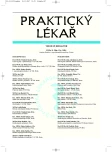Laparoscopic cholecystectomy for cholecystolithiasis and its complications. Retrospective 1-year analysis of 411 patients
Laparoskopická cholecystektomie při cholelitiáze a její komplikace RETROSPEKTIVNÍ ANALÝZA JEDNOROČNÍ SESTAVY 411 OPEROVANÝCH
Východisko:
Laparoskopická cholecystektomie (LCHE) je metodou volby terapie symptomatické cholelitiázy a jejích některých komplikací. Cílem autora je na sestavě nemocných, u kterých byla v průběhu roku 2005 provedena cholecystektomie, zhodnotit její výsledky, procento konverzí, jejich příčinu a časné komplikace.
Materiál a metoda:
Na chirurgické klinice 2. LF UK a ÚVN Praha jsme v roce 2005 provedli 411 cholecystektomií, laparoskopicky z nich 296. Klasickou cholecystektomii jsme provedli u 101 pacienta z celkového počtu 115 jako součást většího operačního výkonu: při operacích GITu, při resekci pankreatu, při jaterních resekcích, při benigních i maligních afekcích zevních žlučových cest, při kolorektálních malignitách, při maligním iktera ošetřeném paliativní biliodigestivní spojkou. 14 cholecystektomií jsme provedli primárně pro cholelitiázu a její zánětlivé komplikace či při podezření na tumor žlučníku klasicky.
Výsledky:
U 29 operovaných (9,8 % z 296 laparoskopických operací) došlo ke konverzi laparoskopické operace na výkon otevřený. Jedenkrát byla nutná po konverzi časná reoperace pro subfrenický absces a pravostranný pleurální výpotek. Ranné infekce po LCHE jsme zaznamenali u 32 nemocných, tj. v 10,8 %. Nejčastěji se jednalo o serom v ráně v místě zavedeného paraumbilikálního videoportu (18 x, tj. v 6,8 %). Sekundární hojení ran po zbývajících portech jsme nalezli u 17 nemocných, tj. ve 4,7 %, z toho u 2 nemocných s dehiscencí fascie (0,69 %). Biliární leak, tj. únik žluči, jsme zjistili v jednom případě, tj. u 0, 33 % operovaných. Odezněl spontánně při prolongované drenáži. U 2 nemocných jsme zaznamenali prodlouženou pooperační parézu střevní (tj. do 5 dnů po operaci). Taktéž spontánně odezněla. V naší sestavě jsme nepozorovali peroperační poranění žlučových cest, žádný z našich pacientů časně po operaci nezemřel.
Klíčová slova:
cholecystektomie, komplikace laparoskopické cholecystektomie, konverze.
Authors:
M. Ryska; H. Kvičerová; V. Vlasák
Authors‘ workplace:
Chirurgická klinika 2. LF UK a ÚVN Praha
; Přednosta: Prof. MUDr. Miroslav Ryska, CSc.
Published in:
Prakt. Lék. 2007; 87(12): 732-735
Category:
Of different specialties
Overview
Background:
Laparoscopic cholecystectomy (LCHE) is the method of choice for the treatment of symptomatic cholelithiasis and its complications. The authors set out to analyze outcomes of cholecystectomy over a one-year period, the conversion percentage, their reasons and early postoperative complications.
Material and methods:
411 cholecystectomies were performed in the Department of Surgery at the 2nd Medical School, of Charles University and at The Central Military hospital in Prague within a one year period (2005), 296 of them by laparoscopic approach. Classic cholecystectomies was performed in 101 patients from a total number of 115 operations as a part of more extensive abdominal operations: during GIT operation, pancreas resection, liver resection, operations for benign and malign affections of extrahepatic bile duct, during operations for colorectal malignity, and operation for malign icterus with construction of palliative biliodigestive anastomosis. 14 cholecystectomies were carried out classically for cholelithiasis and its inflammatory complications or upon suspicion of gallbladder tumour.
Results:
In 29 patients (9.8 % from 296 laparoscopic operations), conversion from laparoscopy to open operation was necessary. In one patient after conversion, early re-operation for subphrenic abscess and punction of right pleural exudates was needed. We noticed wound infection in 32 cases (10.8 %). Fluid at the site of paraumbilical video port installation occurred in 18 patients (6.8%). Secondary wound healing at the other incisions occurred in 17 patients (4.7 %), with co-incidence of fascia dehiscence in 2 cases (0.69 %). We identified biliary leak in one case (0.33 %), but this stopped spontaneously following prolonged drainage. We noted extended postoperative gut paresis (until the 5th postoperative day) in 2 patients, this also spontaneously subsided. In our group of patients, we did not note perioperative bile duct injury, and no patients died following the procedure.
Key words:
Laparoscopic cholecystectomy, complications of laparoscopic cholecystectomy, conversion.
Labels
General practitioner for children and adolescents General practitioner for adultsArticle was published in
General Practitioner

2007 Issue 12
- Memantine Eases Daily Life for Patients and Caregivers
- Metamizole vs. Tramadol in Postoperative Analgesia
- Metamizole at a Glance and in Practice – Effective Non-Opioid Analgesic for All Ages
- Memantine in Dementia Therapy – Current Findings and Possible Future Applications
- What Effect Can Be Expected from Limosilactobacillus reuteri in Mucositis and Peri-Implantitis?
Most read in this issue
- Functional systems of the human brain
- Laparoscopic cholecystectomy for cholecystolithiasis and its complications. Retrospective 1-year analysis of 411 patients
- Intestinal tapeworms. Do they still exist? Are they still able to surprise us?
- Typical and atypical forms of Celiac disease in adults
